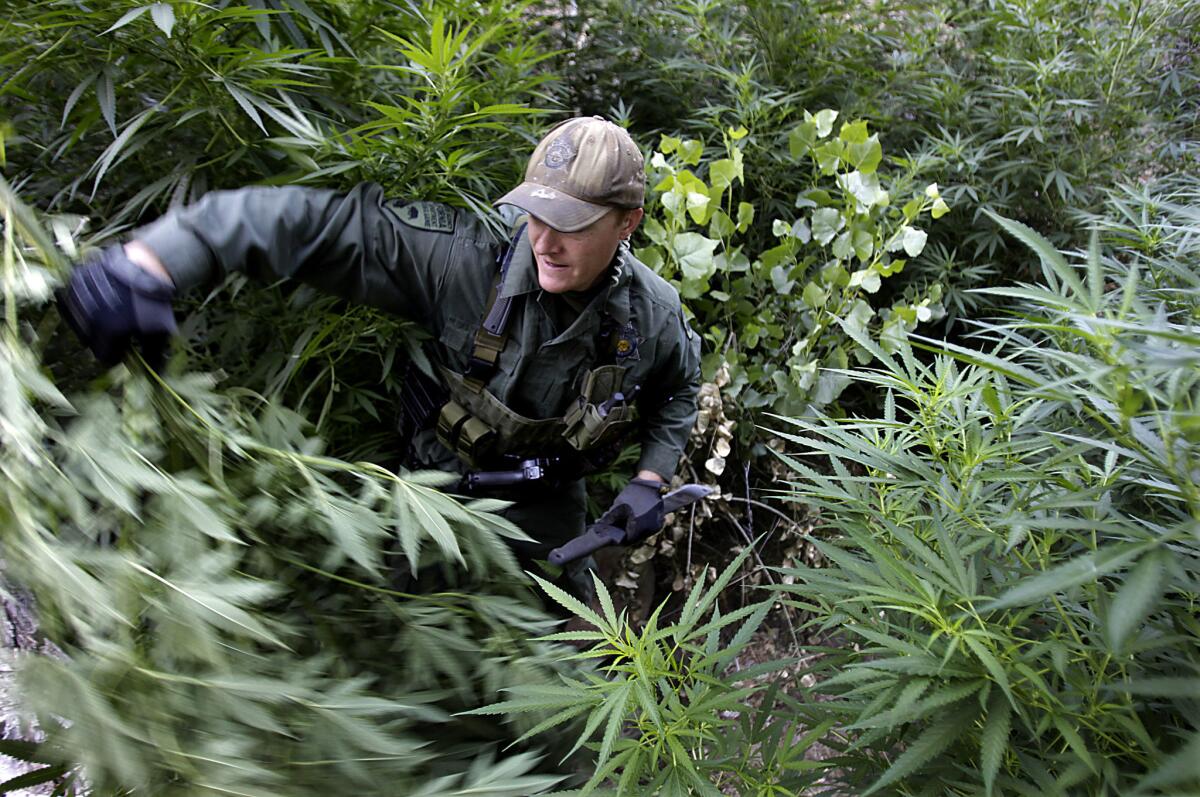California sets new rules for medical pot industry

A warden with the California Department of Fish and Game hacks down marijuanan plants found growing in a deep ravine in the Sierra Nevada foothills near Kernville.
- Share via
Reporting from Sacramento — Nearly two decades after Californians legalized marijuana for medical use and a year before they may approve it for recreational purposes, Gov. Jerry Brown has imposed statewide rules on the growth, transport and sale of the drug.
Signing a trio of related bills Friday, the governor created a regulatory system for medical cannabis that could be adapted for widespread use if voters make it legal by passing a 2016 ballot initiative.
Marijuana advocates have proposed at least five measures for the ballot, and several groups are working to find one they believe will most appeal to voters.
The governor worked out the new regulations with lawmakers after several years of failed attempts by the Legislature to adopt rules that address conflicting concerns of law enforcement and the billion-dollar marijuana industry.
“This new structure will make sure patients have access to medical marijuana, while ensuring a robust tracking system,” Brown wrote in his signing message. “This sends a clear and certain signal to our federal counterparts that California is implementing robust controls not only on paper, but in practice.”
He noted that some of the standards, including the licensing system, don’t take effect until Jan. 1, 2018. But, he said, “state agencies will begin working immediately with experts and stakeholders on crafting clear guidelines, so local government, law enforcement, businesses, patients and health providers can prepare and adapt to the new regulated system.”
An estimated 1,250 medical marijuana dispensaries are operating in the state, with sales of about $1.3 billion, according to industry groups.
“Gov. Brown and his colleagues in the Legislature have just given the green light to let California’s cannabis industry become the thriving, taxpaying, job-creating industry it was always destined to become,” said Nate Bradley, executive director of the California Cannabis Industry Assn., which welcomed regulation.
The new laws create a state Bureau of Medical Marijuana Regulation to issue and revoke licenses for the cultivation, storage and sale of cannabis and collect fees to pay for the agency’s work.
Cities and counties will also have the power to issue and revoke local permits, adopt tougher restrictions on dispensary operations and ask voters to approve taxes on marijuana growers and dispensaries to pay for local public safety expenses.
Currently, some cities and counties have ordinances allowing them to license and limit the number of dispensaries. The new laws preserve the ability of Los Angeles to prosecute businesses that violate rules set by voters in 2013.
The new state bureau, to operate within the administration’s Department of Consumer Affairs, will convene an advisory committee to develop standards and regulation aimed at protecting patients.
Some $10 million has been set aside to fund implementation of the new laws for the first year. But the hiring of staff, development of new regulations and issuing of licenses will probably take longer, according to Russ Heimerich, a spokesman for the Department of Consumer Affairs.
The state departments of Public Health and Food and Agriculture will enforce rules on the quality of marijuana and growing practices.
The new laws designate marijuana as an agricultural product, subject to the same regulations on insecticide and water use as other crops. That will address the negative environmental impact of illegal growing operations, said state Sen. Mike McGuire (D-Healdsburg), author of one of the bills.
Brown said he was directing his Natural Resources Agency to identify projects to begin restoration of land damaged by marijuana growing.
He hailed California’s “new path for responsible marijuana cultivation” but added, “The damage to our ecosystem is occurring today.”
California voters legalized medical cannabis in 1996 when they passed the Compassionate Use Act. A proliferation of pot shops has since been regulated by a patchwork of city and county ordinances that ban them from some areas and allow a significant number in others.
Although federal law makes the sale of even medical marijuana a crime, the U.S. Department of Justice issued a memorandum in 2013 saying prosecution should focus on the most serious threats.
That memo put pressure on California to adopt strong regulations, because it indicated that states with such rules would be less likely to see prosecutions of medical marijuana license holders.
The new rules were also welcomed by growers, including Ata Gonzalez, chief executive of G FarmaLabs, who is a cultivator and distributor to more than 600 dispensaries in California.
Gonzalez recently bought land in Desert Hot Springs for a processing plant and indoor growing.
The new rules will require him to alter his operations, but Gonzalez said he would adjust.
“Personally, I don’t believe anyone will ever be 100% happy with the way these regulations were going to be written, but I have to tell you, [our firm] appreciates this well-thought-out set of guidelines,” Gonzalez said, predicting “a good and positive outcome.”
For more on California government, go to www.latimes.com/politics
ALSO:
Massive El Niño is now ‘too big to fail,’ scientist says
Does a college student have the right to invite guests to an apartment?
Group tries to teach lawmakers how to talk about pot
More to Read
Sign up for Essential California
The most important California stories and recommendations in your inbox every morning.
You may occasionally receive promotional content from the Los Angeles Times.











